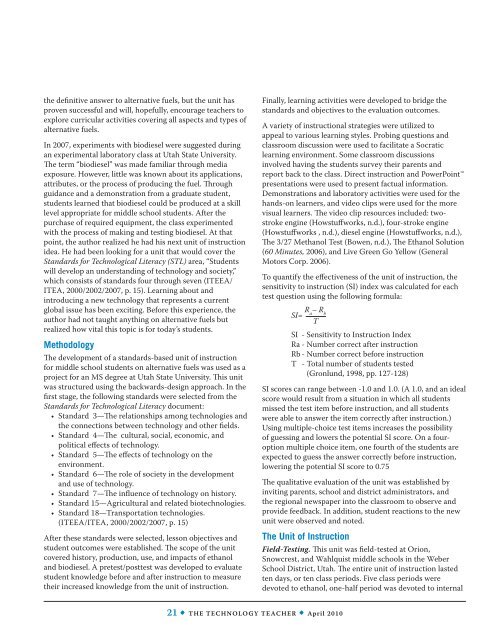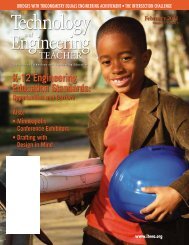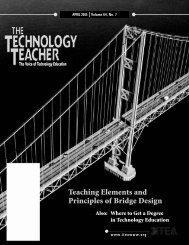Medical Technology: organ harvesting and Transplants
Medical Technology: organ harvesting and Transplants
Medical Technology: organ harvesting and Transplants
You also want an ePaper? Increase the reach of your titles
YUMPU automatically turns print PDFs into web optimized ePapers that Google loves.
the definitive answer to alternative fuels, but the unit has<br />
proven successful <strong>and</strong> will, hopefully, encourage teachers to<br />
explore curricular activities covering all aspects <strong>and</strong> types of<br />
alternative fuels.<br />
In 2007, experiments with biodiesel were suggested during<br />
an experimental laboratory class at Utah State University.<br />
The term “biodiesel” was made familiar through media<br />
exposure. However, little was known about its applications,<br />
attributes, or the process of producing the fuel. Through<br />
guidance <strong>and</strong> a demonstration from a graduate student,<br />
students learned that biodiesel could be produced at a skill<br />
level appropriate for middle school students. After the<br />
purchase of required equipment, the class experimented<br />
with the process of making <strong>and</strong> testing biodiesel. At that<br />
point, the author realized he had his next unit of instruction<br />
idea. He had been looking for a unit that would cover the<br />
St<strong>and</strong>ards for Technological Literacy (STL) area, “Students<br />
will develop an underst<strong>and</strong>ing of technology <strong>and</strong> society,”<br />
which consists of st<strong>and</strong>ards four through seven (ITEEA/<br />
ITEA, 2000/2002/2007, p. 15). Learning about <strong>and</strong><br />
introducing a new technology that represents a current<br />
global issue has been exciting. Before this experience, the<br />
author had not taught anything on alternative fuels but<br />
realized how vital this topic is for today’s students.<br />
Methodology<br />
The development of a st<strong>and</strong>ards-based unit of instruction<br />
for middle school students on alternative fuels was used as a<br />
project for an MS degree at Utah State University. This unit<br />
was structured using the backwards-design approach. In the<br />
first stage, the following st<strong>and</strong>ards were selected from the<br />
St<strong>and</strong>ards for Technological Literacy document:<br />
• St<strong>and</strong>ard 3—The relationships among technologies <strong>and</strong><br />
the connections between technology <strong>and</strong> other fields.<br />
• St<strong>and</strong>ard 4—The cultural, social, economic, <strong>and</strong><br />
political effects of technology.<br />
• St<strong>and</strong>ard 5—The effects of technology on the<br />
environment.<br />
• St<strong>and</strong>ard 6—The role of society in the development<br />
<strong>and</strong> use of technology.<br />
• St<strong>and</strong>ard 7—The influence of technology on history.<br />
• St<strong>and</strong>ard 15—Agricultural <strong>and</strong> related biotechnologies.<br />
• St<strong>and</strong>ard 18—Transportation technologies.<br />
(ITEEA/ITEA, 2000/2002/2007, p. 15)<br />
After these st<strong>and</strong>ards were selected, lesson objectives <strong>and</strong><br />
student outcomes were established. The scope of the unit<br />
covered history, production, use, <strong>and</strong> impacts of ethanol<br />
<strong>and</strong> biodiesel. A pretest/posttest was developed to evaluate<br />
student knowledge before <strong>and</strong> after instruction to measure<br />
their increased knowledge from the unit of instruction.<br />
Finally, learning activities were developed to bridge the<br />
st<strong>and</strong>ards <strong>and</strong> objectives to the evaluation outcomes.<br />
A variety of instructional strategies were utilized to<br />
appeal to various learning styles. Probing questions <strong>and</strong><br />
classroom discussion were used to facilitate a Socratic<br />
learning environment. Some classroom discussions<br />
involved having the students survey their parents <strong>and</strong><br />
report back to the class. Direct instruction <strong>and</strong> PowerPoint<br />
presentations were used to present factual information.<br />
Demonstrations <strong>and</strong> laboratory activities were used for the<br />
h<strong>and</strong>s-on learners, <strong>and</strong> video clips were used for the more<br />
visual learners. The video clip resources included: twostroke<br />
engine (Howstuffworks, n.d.), four-stroke engine<br />
(Howstuffworks , n.d.), diesel engine (Howstuffworks, n.d.),<br />
The 3/27 Methanol Test (Bowen, n.d.), The Ethanol Solution<br />
(60 Minutes, 2006), <strong>and</strong> Live Green Go Yellow (General<br />
Motors Corp. 2006).<br />
To quantify the effectiveness of the unit of instruction, the<br />
sensitivity to instruction (SI) index was calculated for each<br />
test question using the following formula:<br />
SI= R – R a b<br />
T<br />
SI - Sensitivity to Instruction Index<br />
Ra - Number correct after instruction<br />
Rb - Number correct before instruction<br />
T - Total number of students tested<br />
(Gronlund, 1998, pp. 127-128)<br />
SI scores can range between -1.0 <strong>and</strong> 1.0. (A 1.0, <strong>and</strong> an ideal<br />
score would result from a situation in which all students<br />
missed the test item before instruction, <strong>and</strong> all students<br />
were able to answer the item correctly after instruction.)<br />
Using multiple-choice test items increases the possibility<br />
of guessing <strong>and</strong> lowers the potential SI score. On a fouroption<br />
multiple choice item, one fourth of the students are<br />
expected to guess the answer correctly before instruction,<br />
lowering the potential SI score to 0.75<br />
The qualitative evaluation of the unit was established by<br />
inviting parents, school <strong>and</strong> district administrators, <strong>and</strong><br />
the regional newspaper into the classroom to observe <strong>and</strong><br />
provide feedback. In addition, student reactions to the new<br />
unit were observed <strong>and</strong> noted.<br />
The Unit of Instruction<br />
Field-Testing. This unit was field-tested at Orion,<br />
Snowcrest, <strong>and</strong> Wahlquist middle schools in the Weber<br />
School District, Utah. The entire unit of instruction lasted<br />
ten days, or ten class periods. Five class periods were<br />
devoted to ethanol, one-half period was devoted to internal<br />
21 • The <strong>Technology</strong> Teacher • April 2010

















